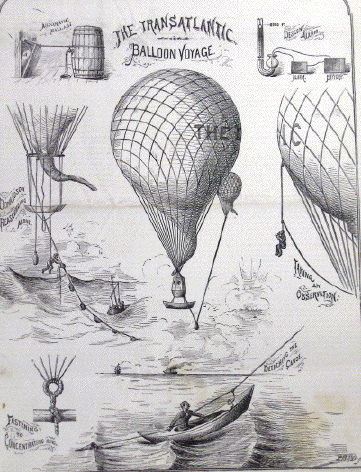"Professor" Donaldson
- or -
Paper Boats Aloft
While reading the Waters & Sons advertising brochure from 1878 we were puzzled by a reference to a "late Professor W. H. Donaldson" as a user of a paper canoe in a paddle &/or sail from New York City to Long Branch, NJ. He is said to have used the "Nautilus" or "Baden Powell" model canoe. It was hardly an adventure like those of Julius Chambers and Nathaniel Bishop, (also listed by Waters.) Chambers & Bishop had gone down the Mississippi and East Coast respectively in one of Waters' craft while Donaldson seemed to have taken a nice day trip. Interest was piqued again when visiting the Adirondack Museum and seeing a photo of Donaldson's paper canoe in the "other materials" for canoes part of their small boat exhibit.
So who was Donaldson?
Had we had lived in the 1870's we would have recognized the name immediately. He was a famous aeronaut of the period. Recall that this was before the Wright brothers. The cutting edge of aerospace technology was a reasonably well-executed balloon ascension. The norm appears to have been a less-then-well-executed ascension, (which makes for interesting and I must admit darkly entertaining reading in the research I've done.)
He began life as an acrobat, appearing on stage and at outdoor locations, at least once in the employ of P. T. Barnum. One account credits him as being the first person to ride a bicycle on a high wire. Typical of his feats was a walk on a 1,800 foot long rope suspended over the Upper Falls of the Genesee River, in Rochester, NY. However, balloon ascensions allowed him to really attract attention, performing his acrobatic feats from a trapeze drifting high above his audience. He recorded 138 largely successful ascensions. We will return later to the 139th.

Donaldson, however, was involved in grander pursuits than a simple canoe trip which connected him to Waters & Sons. He planned, with the financial help of a New York City newspaper, the Daily Graphic, a trans-Atlantic balloon crossing. He designed what he thought to be a suitable balloon which was built and appropriately named the "Daily Graphic". Unfortunately the balloon ruptured on its initial inflation in New York City in the Fall of 1873. The remnants were fashioned into a smaller version, appropriately named this time, the "New Graphic". It was flown only once, making it as far as New Canaan, CT where it met with a minor disaster , (i.e. all passengers escaped alive, one of the "reasonably well executed" ascensions referred to earlier.) The trans-Atlantic project languished as funding and interest apparently waned.
But..... we note that an essential part of the initial plan was to have the balloon carry two lifeboats. One was a 22' sloop-rigged centerboard lapstreak craft, (built by Ingersoll.) It would accommodate all passengers but Donaldson, should the balloon loose buoyancy. Donaldson would continue on alone and if necessary, seek refuge in the second boat, (a short drum roll, please,) Waters paper canoe which was to carry him to safety. The paper boat was used as the back-up because of its relatively lighter weight. If you're really curious, we can direct you to a Scientific American article from the period. (The illustration on the right is from this source. That's an illustration of Donaldson in the canoe at the bottom of the page.).
Donaldson's relations with boating and paper boating in particular seemed to have been rather tenuous. Perhaps he should have kept up a better relationship.
He eventually perished during an attempt to cross lake Michigan. He left on his 139th and final balloon voyage in 1875 from the Hippodrome grounds in a Chicago suburb. He was accompanied by a lone passenger, a reporter from the Chicago Evening Journal. They were last seen traveling roughly in the right direction, towards Grand Haven, MI but also in the direction of a line of thunderstorms. The reporter washed ashore one month later, considerably worse for the wear. The famous W.H. Donaldson was never seen again.
For more information on Donaldson and 19th century ballooning, try Tom D. Crouch, The Eagle Aloft, Smithsonian Institution Press, 1983 or as a second choice, D. Wiggins, The Air Devils, Lippincott Co., Philadelphia 1966. Unfortunately neither of these references mention the paper canoe. You would need to go to the Daily Graphic of Sept. 10th, 1873 for this information.